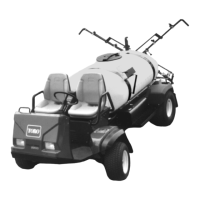25
OPERATING INSTRUCTIONS
BRAKING
The MULTI PRO
®
5500 Turf Sprayer has a
hydrostatic braking system, which means that
when the vehicle is not being propelled into motion
it is stopped. The vehicle will not coast under
normal operation.
It is good practice to slow down before
approaching an obstacle. This gives you extra
time to stop or turn away. Hitting an obstacle can
damage the vehicle and its contents. More
importantly, it can injure you.
Gross vehicle weight has a major impact on your
ability to stop and/or turn. Heavier loads and
heavier attachments make a vehicle harder to stop
or turn. The heavier the load, the longer it takes
to stop.
The braking characteristics also change with no
bed or attachments on the vehicle. Fast stops
may cause the rear wheels to lock up, which may
affect the control of the vehicle. Its a good idea to
decrease the vehicle speed with no bed or
attachments.
Turf and pavement are much more slippery when
wet. It can take 2 to 4 times as long to stop on wet
surfaces as on dry surfaces.
NOTE: Heavy loads and turf conditions affect
your vehicle's brake performance and ability
to turn quickly without tipping over.
TIPOVERS
The best way to prevent accidents involving Turf
Sprayer is through continuous supervision and
training of operators and paying constant attention
to the area in which the vehicle is being operated.
The best way for operators to prevent serious injury
or death to themselves or others is to familiarize
themselves with the proper operation of the Turf
Sprayer, to stay alert and to avoid action or
conditions which could result in an accident. In
the event of a tip over, the risk of serious injury or
even death will be reduced if the operator and all
involved follow the instructions provided.
WARNING
HILLS
Use extra care when on hills. Never go on hills
that are extremely steep. Stopping while going
down a hill will take longer than on level ground.
Turning while going up or down a hill is more
dangerous than turning on the level. Turning while
going down hill, especially with the brakes on, and
turning up hill while traversing a hill, are particularly
dangerous. Even at a slow speed and without a
load, tipovers are more likely if you turn on a hill.
Do not accelerate while climbing or descending a
hill. If you have to turn while on a hill, do it as
slowly and cautiously as possible. Never make
sharp or fast turns on a hill.
If you stall or begin to lose headway while climbing
a hill, quickly apply the brakes, engage emergency
brake, and restart the engine.
Tipping or rolling the vehicle could cause
serious personal injury or death.
If engine stalls or you lose momentum
on a hill, never attempt to turn vehicle
around.
When backing down a hill always back
straight down.
Never drive across a steep hill, always
drive straight up or down.
Avoid turning on a hill.
1149

